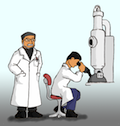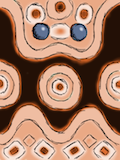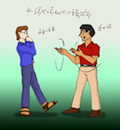Design¶
To design your simulation, you need to decide all the practical details from the small and technical to the grand scheme. Here are some important questions for you to consider, to help guide the planning of the research. Note that most of these questions have no clear right or wrong answers, but the choices may affect what you are actually measuring in the end.
Simulation¶

To simulate friction, you need to drag one surface against another. This can be done in many ways, but in any case you need to somehow constrain the motion of the surfaces: the surface in motion has to (at least try) to move sideways, and it has to stay in contact with the static surface.
- How can you achieve these conditions?
- How can you define these constraints in the simulation (also see the list of predefined constraints provided in the simulation Tools)?
- Does it matter how the moving surface is orientated, or in what direction it moves?
Measurement¶

There are many aspects to friction: it can be seen as a force, but it is also a process consuming energy. It can be static, preventing the onset of motion, or dynamic, opposing movement.
- What kind of friction do you wish to study?
- What physical measurable would allow you to quantify the type of friction you are interested in?
- How can you measure this quantity in an atomistic simulation? (Also pay in mind the constraints you are applying. You should be careful not to measure something that is affected by these constraints.)
- Can you make a graphical representation of your data?
Exploration¶
Usually results depend on conditions. This is also true for friction. Therefore it is not very interesting to measure friction at one specific set of conditions and claim your result is the universal truth. Moreover, since simulations are only a model of reality, the results obtained from them cannot be trusted unless verified against experiments and even then the absolute values may be wrong. Due to these reasons, it is usually most interesting to see how results change as a function of external physical parameters or simulation details.

You should choose one parameter to vary and some reasonable range of values for it in your simulations. Possible variables are, for instance:
- temperature
- surface-surface distance
- drag speed and direction
- surface materials (changing the atomic interaction changes the type of atom represented)
- orientation of moving surface (does matching of surface atomic structure affect friction)
- nature of the moving surface (how will friction change if you use a sharp atomic needle rather than a surface as the contact?)
- role of lubrication
Hypothesize¶

Sometimes research is done by just exploring, but usually you have some guess, a hypothesis, of what will happen in your experiment. Having an idea of what are the possible outcomes of different scenarios allows you to pick the one which is most likely to produce something interesting. On the other hand, if a result is something unexpected, it can be an indication that the phenomenon should be investigated in more detail.
You should estimate what happens in your simulation. Especially consider what is likely to happen when you change the parameter you decided to vary.